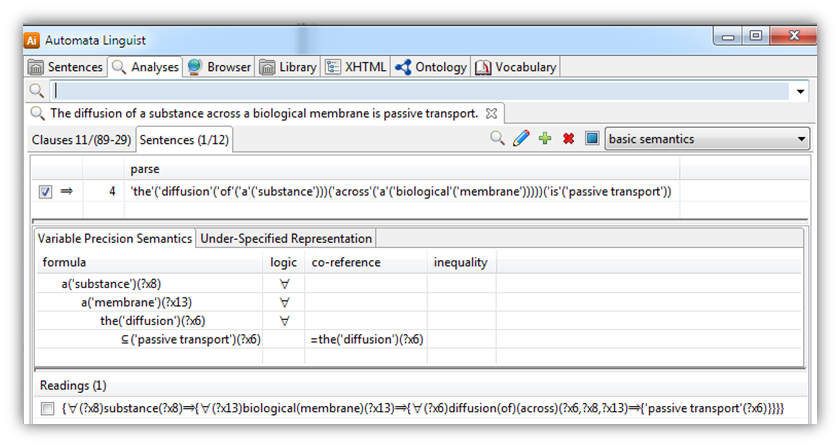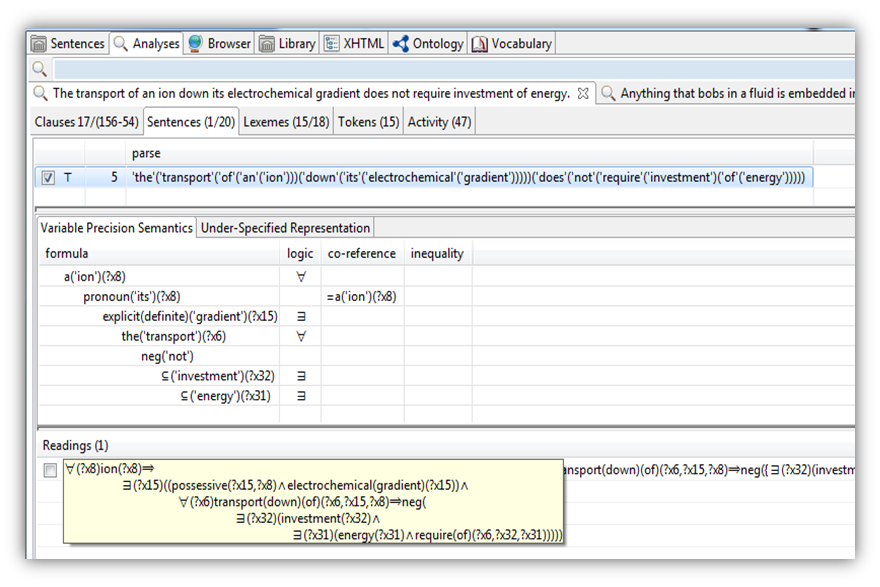We’re working with the English Resource Grammar (ERG), OWL, and Vulcan’s SILK to educate the machine by translating textbooks into defeasible logic. Part of this involves an ontology that models semantics more deeply than the ERG, which is based on head-driven phrase structure grammar (HPSG), which provides deeper parsing and, with the ERG and the DELPH-IN infrastructure, also provides a simple under-specified semantic representation called minimal recursion semantics (MRS).
We’re having a great time using OWL to clarify and enrich the semantics of the rich model underlying the ERG. Here’s an example, FYI. If you’d like to know more (or help), please drop us a line! Overall the project will demonstrate our capabilities for transforming everyday sentences into RIF and business rule languages using SBVR extended with defeasibility and other capabilities, all modeled in the same OWL ontology.
What triggered this blog entry was a bit of a surprise in seeing that whether or not an adjective could be used depictively is sometimes encoded in the lexicon. This is one of the problems of TDL versus a description-logic based model with more expressiveness. It results in more lexical entries than necessary, which has been discussed by others when contrasted with the attributed logic engine (ALE), for example.
In trying to model the semantics of words like ‘same’ and ‘different’, we are scratching our heads about these lines from the ERG’s lexicon:
- same_a1 := aj_pp_i-cmp-sme_le & [ ORTH < “same” >, SYNSEM [ LKEYS.KEYREL.PRED “_same_a_as_rel”, …
- the_same_a1 := aj_-_i-prd-ndpt_le & [ ORTH < “the”, “same” >, SYNSEM [ LKEYS.KEYREL.PRED “_the+same_a_1_rel”, …
- the_same_adv1 := av_-_i-vp-po_le & [ ORTH < “the”, “same” >, SYNSEM [ LKEYS.KEYREL.PRED “_the+same_a_1_rel”, …
- exact_a2 := aj_pp_i-cmp-sme_le & [ ORTH < “exact” >, SYNSEM [ LKEYS.KEYREL.PRED “_exact_a_same-as_rel”…
One of the interesting things about lexicalized grammars is that lexical entries (i.e., ‘words’) are described with almost arbitrary combinations of their lexical, syntactic, and semantic characteristics.
The preceding code is expressed in a type description language (TDL) used by the Lisp-based LKB (and its C++ counterpart, PET, which are unification-based parsers that produce a chart of plausible parses with some efficiency. What is given above is already deeper than what you can expect from a statistical parser (but richer descriptions of lexical entries promises to make statistical parsing much better, too).
Unfortunately, there is no available documentation on why the ERG was designed as it is, so the meaning of the above is difficult to interpret. For example, the types of lexical entries (the symbols ending in ‘_le’) referenced above are defined as follows:
- aj_pp_i-cmp-sme_le := basic_adj_comp_lexent & [SYNSEM[LOCAL[CAT[HEAD superl_adj &[PRD -,MOD <[LOCAL.CAT.VAL.SPR <[–MIN def_or_demon_q_rel]>]>],VAL.SPR.FIRST.–MIN much_deg_rel],CONT.RELS <!relation,relation!>],MODIFD.LPERIPH bool,LKEYS[ALTKEYREL.PRED comp_equal_rel,–COMPKEY _as_p_comp_rel]]].
- aj_-_i-prd-ndpt_le := nonc-hm-nab & [SYNSEM basic_adj_abstr_lex_synsem & [LOCAL[CAT[HEAD adj & [PRD +,MINORS[MIN norm_adj_rel,NORM norm_rel],TAM #tam,MOD < anti_synsem_min >],VAL[SPR.FIRST anti_synsem_min,COMPS < >],POSTHD +],CONT[HOOK[LTOP #ltop,INDEX #arg0 &[E #tam],XARG #xarg],RELS <! #keyrel & adj_relation !>,HCONS <! !>]],NONLOC non-local_none,MODIFD notmod &[LPERIPH bool],LKEYS.KEYREL #keyrel &[LBL #ltop,ARG0 #arg0,ARG1 #xarg & non_expl-ind]]].
Needless to say, that’s a mouthful! Chasing this down, the following ‘informs’ us that “the same”, which uses type #2 above, is defined using the following lexical types:
- nonc-hm-nab := nonc-h-nab & mcna.
- nonc-h-nab := nonconj & hc-to-phr & non_affix_bearing.
- mcna := word & [ SYNSEM.LOCAL.CAT.MC na ].
Which is to say that it is non-conjunctive, complements a head to form a phrase, can’t be affixed, cannot constitute a main clause, and is a word.
The fact that the lexical entry for “the same” is adjectival is given the definition of the following type(s) used in the SYNSEM feature:
- basic_adj_comp_lexent := compar_superl_adj_word & [SYNSEM adj_unsp_ind_twoarg_synsem & [LOCAL[CAT.VAL[COMPS <canonical_or_unexpressed & [–MIN #cmin,LOCAL [CAT basic_pp_cat,CONJ cnil,CONT.HOOK [LTOP #ltop,INDEX #ind]]]>],CONT.HOOK [ LTOP #ltop, XARG #xarg]],LKEYS [ KEYREL.ARG1 #xarg,ALTKEYREL.ARG2 #ind,–COMPKEY #cmin]]].b
- compar_superl_adj_word := nonc-hm-nab & [SYNSEM adj_unsp_ind_synsem & [LOCAL[CAT[HEAD[MOD <[–SIND #ind & non_expl]>,TAM #tam,MINORS.MIN abstr_adj_rel],VAL.SPR.FIRST.LOCAL.CONT.HOOK.XARG #altarg0],CONT[HOOK[XARG #ind,INDEX #arg0 & [E #tam]],RELS.LIST <[LBL #hand,ARG1 #ind],#altkeyrel & [LBL #hand,ARG0 event & #altarg0,ARG1 #arg0],…>]],LKEYS.ALTKEYREL #altkeyrel]].
Which is to say that it is a comparative or superlative adjectival word (even though it consists of two lexemes in its ‘orthography’) that involves two semantic arguments including one complement which may be unexpressed prepositional phrase. A comparative or superlative adjective, in turn, is non-conjunctive, complements a head to form a phrase, is non-affix bearing (?), and non-clausal, as defined by the type ‘nonc-hm-nab’ above.
The types used in the syntax and semantic (i.e., SYNSEM) feature of the two lexical types are defined as follows (none of which is documented):
- adj_unsp_ind_twoarg_synsem := adj_unsp_ind_synsem & two_arg.
- adj_unsp_ind_synsem := basic_adj_lex_synsem & lex_synsem & adj_synsem_lex_or_phrase & isect_synsem & [LOCAL.CONT.HOOK.INDEX #ind,LKEYS.KEYREL.ARG0 #ind].
In a moment, we’ll discuss the types used in the second of these, but first, some basics on the semantics that are mixed with the syntax above.
In effect, the above indicates that a new ‘elementary predication’ will be needed in the MRS to represent the adjectival relationship in the logic derived in the course of parsing (i.e., that’s what ‘unsp_ind’ means, although it’s not documented, which I will try not to bemoan much further.)
The following indicates that the newly formed elementary predicate is not (initially) within any scope and that it has two arguments whose semantics (i.e., their RELations) are concatenated for propagation into the list of elementary predications that will constitute the MRS for any parses found.
- two_arg := basic_two_arg & [LOCAL.CONT.HCONS <! !>].
- basic_two_arg := unspec_two_arg & lex_synsem.
- unspec_two_arg := basic_lex_synsem & [LOCAL.ARG-S <[LOCAL.CONT.HOOK.–SLTOP #sltop,NONLOC [SLASH[LIST #smiddle,LAST #slast],REL [LIST #rmiddle,LAST #rlast],QUE[LIST #qmiddle,LAST #qlast]]],[LOCAL.CONT.HOOK.–SLTOP #sltop, NONLOC[SLASH[LIST #sfirst,LAST #smiddle],REL[LIST #rfirst,LAST #rmiddle],QUE[LIST #qfirst,LAST #qmiddle]]]>,LOCAL.CONT.HOOK.–SLTOP #sltop,NONLOC[SLASH[LIST #sfirst,LAST #slast],REL[LIST #rfirst,LAST #rlast],QUE[LIST #qfirst,LAST #qlast]]].
- lex_synsem := basic_lex_synsem & [LEX +].
The last of these expresses that the constuction is lexical rather than phrasal (which includes clausal in the ERG).
Continuing with the definition of “the same” as an adjective, the following finally clarifies what it means to be a basic adjective:
- basic_adj_lex_synsem := basic_adj_abstr_lex_synsem & [LOCAL[ARG-S <#spr . #comps>,CAT[HEAD adj_or_intadj,VAL[SPR<#spr & synsem_min &[–MIN degree_rel,LOCAL[CAT[VAL[SPR *olist*,SPEC <[LOCAL.CAT.HS-LEX #hslex]>],MC na],CONT.HOOK.LTOP #ltop],NONLOC.SLASH 0-dlist,OPT +],anti_synsem_min &[–MIN degree_rel]>,COMPS #comps],HS-LEX #hslex],CONT.RELS.LIST <#keyrel,…>],LKEYS.KEYREL #keyrel & [LBL #ltop]].
Well, ‘clarifies’ might not have been the right word! Essentially, it indicates that the adjective may have an optional degree specifier (which semantically modifies the predicate of the adjective) and that the predicate specified in the lexical entry becomes the predicate used in the MRS. The rest is defined below:
- basic_adj_abstr_lex_synsem := basic_adj_synsem_lex_or_phrase & abstr_lex_synsem & [LOCAL.CONT.RELS.LIST.FIRST basic_adj_relation].
- basic_adj_synsem_lex_or_phrase := canonical_synsem & [LOCAL[AGR #agr,CAT[HEAD[MINORS.MIN basic_adj_rel],VAL[SUBJ <>,SPCMPS <>]],CONT.HOOK[INDEX non_conj_sement,XARG #agr]]].
- canonical_synsem := expressed_synsem & canonical_or_unexpressed.
- expressed_synsem := synsem.
- canonical_or_unexpressed := synsem_min0.
- synsem_min0 := synsem_min & [LOCAL mod_local,NONLOC non-local_min].
Which ends with a bunch of basic setup types except for constraining for relation for an adjective to be ‘basically adjectivally’ on the first two lines. Also on these first two lines, it specifies that its subject and its specifier, if any, must be completed (i.e., empty) and agree with its non-conjunctive argument (which is not to say that it cannot be conjunctive, but that it modifies the conjunction as a whole, if so.) Whether or not it is expressed will determine if there are any further predicates about its arguments or if its unexpressed argument is identified by an otherwise unreferenced variable in any resulting MRS.
The lexical grounding of this type specification is given below, indicating that it may (or not) have phonology (e.g., pronunciation, such as whether its onset is voiced) and if and how and with what punctuation it may appear, if any. In general, a semantic argument may be lexical or phrasal and optional but if it appears it corresponds to some semantic index (think variable) in sort of predicate in any resulting MRS. (The *_min types do not constrain the values of their features any further).
- basic_lex_synsem := abstr_lex_synsem & lex_or_nonlex_synsem.
- abstr_lex_synsem := canonical_lex_or_phrase_synsem & [LKEYS lexkeys].
- canonical_lex_or_phrase_synsem := canonical_synsem & lex_or_phrase.
- lex_or_phrase := synsem_min2.
- synsem_min2 := synsem_min1 & [LEX luk,MODIFD xmod_min,PHON phon_min,PUNCT punctuation_min].
- synsem_min1 := synsem_min0 & [OPT bool,–MIN predsort,–SIND *top*].
- adj_synsem_lex_or_phrase := basic_adj_synsem_lex_or_phrase &[LOCAL[CAT.HEAD.MOD <synsem_min &[LOCAL[CAT[HEAD basic_nom_or_ttl & [POSS -],VAL[SUBJ <>,SPR.FIRST synsem &[–MIN quant_or_deg_rel],COMPS <>],MC na],CONJ cnil],–SIND #ind]>,CONT.HOOK.XARG #ind]].
Note that an adjective is not possess-able and that it modifies something nominal (or a title) and that if it has a specifier that it is a quantifier or degree (e.g., ‘very’). Again, an adjective cannot function as a main clause or be conjunctive (in and of itself).
Finally, if you look far above you will see that the basic semantics of an adjective with an additional semantic argument is ‘intersective’, as in:
- isect_synsem := abstr_lex_synsem & [LOCAL[CAT.HEAD.MOD <[LOCAL intersective_mod,NONLOC.REL 0-dlist]>,CONT.HOOK.LTOP #hand],LKEYS.KEYREL.LBL #hand].
Here, the length 0 difference list and the following definitions indicate that intersective semantics do not accept anything but local modification:
- intersective_mod := mod_local.
- mod_local := *avm*.
AVM stands for ‘attribute value matrix’, which is the structure by which types and their features are defined (with nesting and unification constraints using # to indicate equality).
By now you’re probably getting the idea that there is fairly significant model of the English language, including its lexical and syntactic aspects, but if you look there is a lot about semantics here, too.





